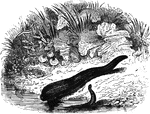Clipart tagged: ‘annelida’
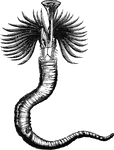
Serpula contortiplicata
"The Serpulae, which form irregularly twisted calcareous tubes, often grow together in large…
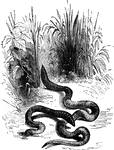
Earth-worms
"The bodies of these animals are of a cylindrical form, somewhat pointed at the anterior extremity,…
Earthworm
The earthworm works through the ground by insinuating its pointed head between the grains of dirt, (Hooker,…
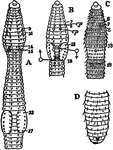
Earthworm
"Diagrams of various earthworms to illustrate external characters. A, B, C, anterior segments from the…
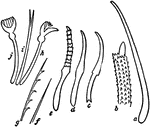
Setae of Earthworm
An illustration of the various types of earthworm setae. Seta (plural: setae) is a biological term derived…
Terebella medusa
"Distinguished by their habit of forming a tube or case, within which the soft parts of the animal can…
Nais
"In their form they resemble the common earth-worm; but their bodies are furnished, besides the ventral…
